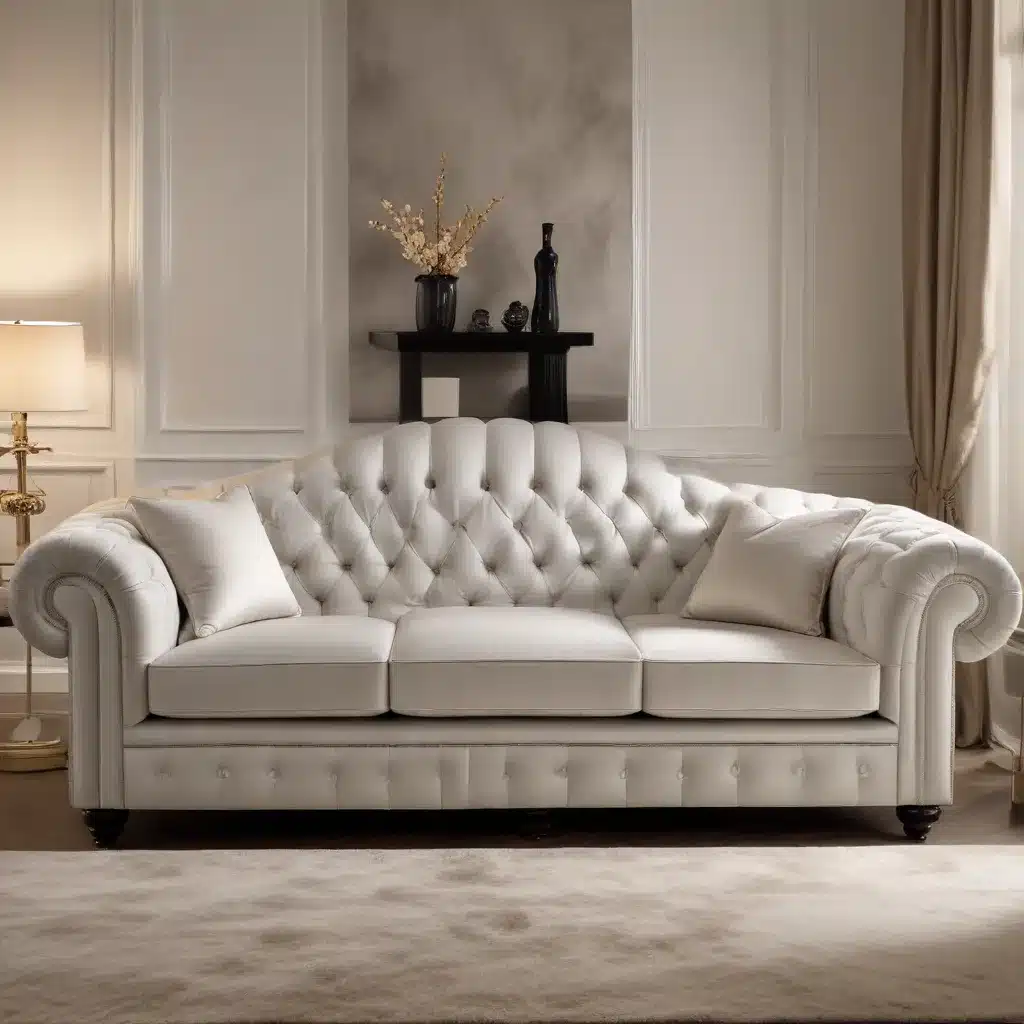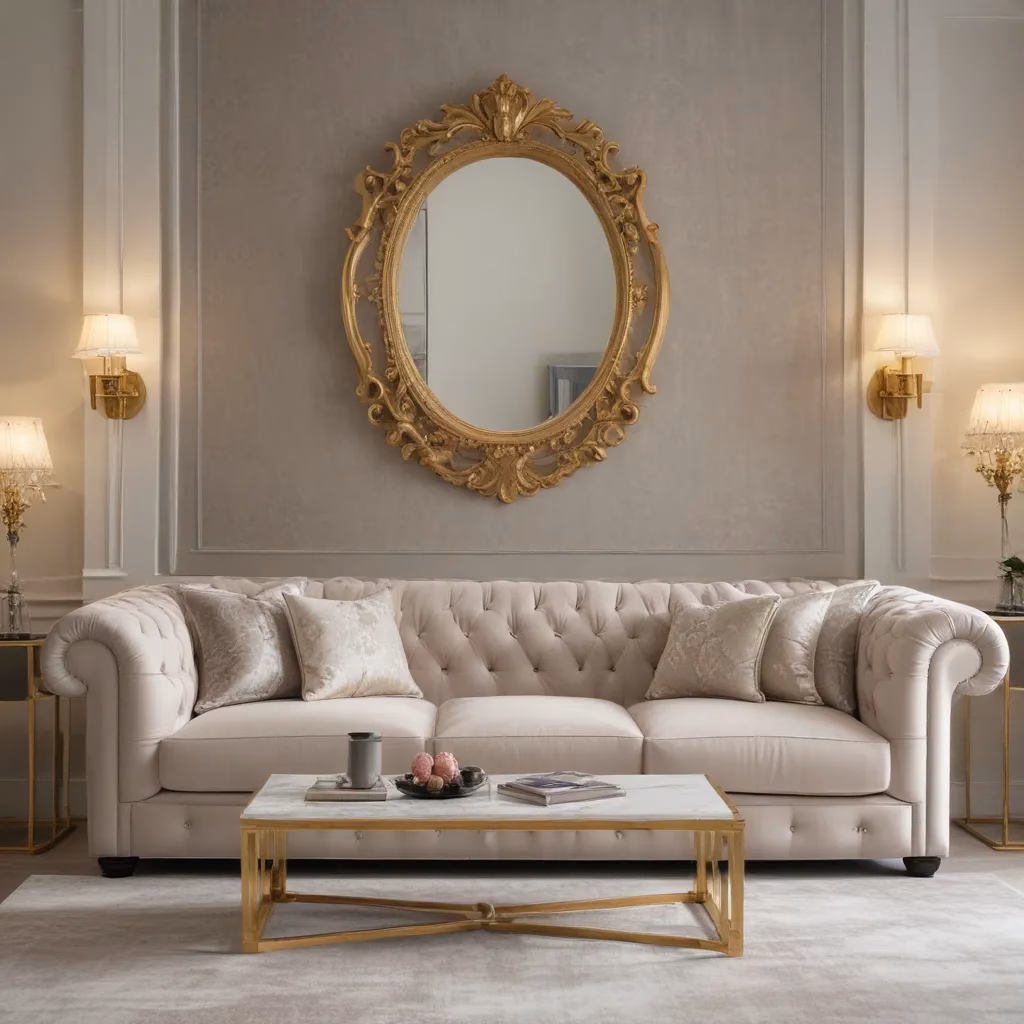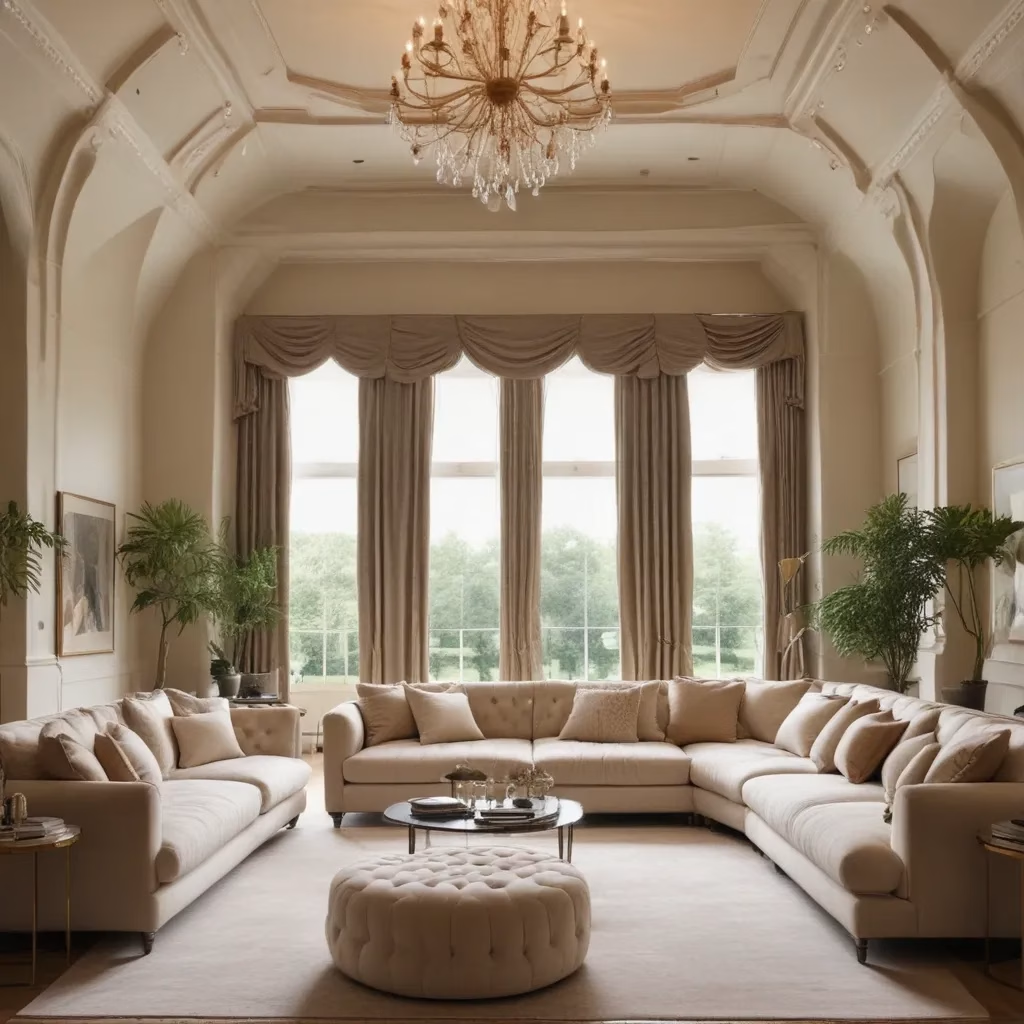
The Art of Blending Classic and Modern Elements
As a furniture specialist with years of experience in the industry, I’ve had the pleasure of witnessing the evolution of sofa design firsthand. One trend that has consistently captured my attention is the seamless integration of timeless elegance with contemporary sophistication. This fusion of styles has become a hallmark of high-quality sofa design, and it’s a approach that I’ve seen executed brilliantly by companies like Sofa Spectacular.
The key to achieving this balance lies in understanding the fundamental elements of both classic and modern design. Traditional sofas often feature rich textures, intricate detailing, and sturdy construction. On the other hand, contemporary pieces are characterized by clean lines, minimalist aesthetics, and innovative materials. When these elements are thoughtfully combined, the result is a sofa that feels both familiar and fresh.
One example of this fusion is the modern interpretation of the Chesterfield sofa. The classic Chesterfield is known for its tufted upholstery and rolled arms, but today’s versions often incorporate sleeker profiles and updated fabrics. This reimagining allows the sofa to maintain its timeless appeal while fitting seamlessly into modern interiors.
Innovative Materials and Textures in Sofa Design
The world of sofa design has seen a revolution in materials and textures in recent years. As a specialist, I’ve been fascinated by the creative ways manufacturers are incorporating new elements to enhance both the visual appeal and functionality of their sofas.
One trend that has caught my eye is the use of performance fabrics. These materials are designed to resist stains, fading, and wear, making them ideal for households with children or pets. What’s remarkable is how these fabrics have evolved to not only be practical but also luxurious to the touch. I’ve run my hands over sofas that feel as soft as velvet but can withstand spills and heavy use – a true marriage of form and function.
Another innovative approach I’ve observed is the incorporation of textured patterns into sofa designs. These patterns, often inspired by natural elements like waves or geological formations, add depth and interest to the sofa without overwhelming the overall design. They create a visual and tactile experience that invites you to engage with the furniture in a new way.
The Rise of Modular Sofa Systems
In my years of experience, I’ve seen a significant shift towards modular sofa systems. These versatile pieces of furniture have become increasingly popular, and for good reason. Modular sofas offer a level of flexibility that traditional fixed-form sofas simply can’t match.
The beauty of modular systems lies in their adaptability. Homeowners can rearrange the components to suit different room layouts or social situations. I’ve worked with clients who have transformed their living spaces by reconfiguring their modular sofas for everything from intimate gatherings to large parties.
Moreover, modular sofas are an excellent solution for those living in urban environments where space is at a premium. The ability to adjust the size and shape of your seating arrangement can make a significant difference in maximizing the functionality of a small living area.
Sustainable Practices in Sofa Manufacturing
Sustainability has become a crucial consideration in furniture design and manufacturing, and sofas are no exception. As someone who has been in the industry for years, I’ve witnessed a growing commitment to eco-friendly practices among leading sofa manufacturers.
One area where I’ve seen significant progress is in the sourcing of materials. Many companies are now using sustainably harvested wood for sofa frames and recycled or organic fibers for upholstery. These choices not only reduce the environmental impact of sofa production but often result in higher-quality, longer-lasting furniture.
Another sustainable practice that’s gaining traction is the concept of circular design. This approach focuses on creating sofas that can be easily disassembled, repaired, and recycled at the end of their life cycle. I’ve been impressed by sofas designed with removable covers and replaceable components, which extend the furniture’s lifespan and reduce waste.
Color Trends in Contemporary Sofa Design
Color plays a crucial role in sofa design, influencing both the aesthetic appeal and the overall mood of a living space. In recent years, I’ve observed some interesting shifts in color preferences among both designers and homeowners.
While neutral tones like beige, gray, and white remain popular for their versatility, I’ve seen a growing interest in bolder color choices. Deep jewel tones such as emerald green, sapphire blue, and rich burgundy have been making a strong statement in contemporary sofa design. These colors add depth and sophistication to a room, creating a focal point that draws the eye.
On the other end of the spectrum, I’ve also noticed a trend towards softer, more muted hues. Pale pinks, sage greens, and dusty blues have been gaining popularity, offering a subtle way to introduce color without overwhelming the space. These gentle tones create a calm, soothing atmosphere that many find appealing in today’s fast-paced world.
The Importance of Comfort in Sofa Design
While style is undoubtedly important, comfort remains a top priority in sofa design. As someone who has tested countless sofas over the years, I can attest to the fact that a beautiful sofa isn’t worth much if it’s not comfortable to sit on.
Modern sofa design has made significant strides in enhancing comfort without sacrificing aesthetics. I’ve been particularly impressed by the advancements in cushion technology. High-resilience foams, memory foam, and even gel-infused materials are being used to create seating that provides optimal support and maintains its shape over time.
Another comfort-focused trend I’ve observed is the rise of deep-seated sofas. These designs allow for a more relaxed, lounging position, which many people find appealing for casual everyday use. However, it’s important to note that seat depth is a personal preference, and what’s comfortable for one person may not be ideal for another.
Sofa Care and Maintenance: Best Practices
As a furniture specialist, one of the most common questions I receive is about sofa care and maintenance. Proper care can significantly extend the life of your sofa and keep it looking its best for years to come.
One of the most important aspects of sofa care is regular cleaning. I always recommend vacuuming your sofa weekly to remove dust and debris. For fabric sofas, it’s also a good idea to use a soft brush attachment to gently agitate the fibers and prevent dirt from becoming embedded.
For leather sofas, I suggest using a specialized leather cleaner and conditioner every few months. This helps to keep the leather supple and prevent cracking. It’s important to avoid using harsh chemicals or excessive water on leather, as these can damage the material.
Protecting your sofa from direct sunlight is another crucial aspect of maintenance. UV rays can cause fading and deterioration of both fabric and leather. If your sofa is placed near a window, consider using curtains or blinds to filter the light.
The Role of Sofas in Interior Design
Throughout my career, I’ve come to appreciate the central role that sofas play in interior design. A well-chosen sofa can set the tone for an entire room, influencing everything from the color scheme to the overall style of the space.
When working with clients on their interior design projects, I often start with the sofa as a foundation piece. Its size, shape, and style can dictate the layout of the room and inform decisions about other furniture and decor elements.
I’ve found that sofas can serve as a bridge between different design elements in a room. For example, a sofa with classic lines but upholstered in a contemporary fabric can help to blend traditional and modern aesthetics. Similarly, a sofa in a bold color can tie together various accent pieces and create a cohesive look.
The Future of Sofa Design: Emerging Trends
As we look to the future of sofa design, I see several exciting trends emerging. One area that I’m particularly interested in is the integration of technology into sofas. I’ve seen prototypes of sofas with built-in charging stations, speakers, and even massage functions. While these features are still relatively new, I believe we’ll see more sophisticated and seamlessly integrated tech solutions in sofas in the coming years.
Another trend I’m watching closely is the use of eco-friendly materials in sofa construction. As sustainability becomes an increasingly important consideration for consumers, I expect to see more sofas made from recycled and biodegradable materials. This could include everything from frames made from reclaimed wood to cushion fillings derived from plant-based sources.
Customization is another area where I see significant potential for growth. With advancements in manufacturing technology, it’s becoming more feasible for companies to offer truly bespoke sofas. This could mean allowing customers to choose not just the fabric and legs, but also the exact dimensions, cushion firmness, and even the internal structure of their sofa.
Choosing the Right Sofa for Your Space
Selecting the perfect sofa for your home can be a daunting task, but as a furniture specialist, I’ve developed some guidelines to help make the process easier. The first step is to consider the size of your space. Measure your room carefully, and don’t forget to account for doorways and staircases – you’ll need to be able to get the sofa into your home!
Next, think about how you’ll be using the sofa. If it’s for a formal living room that’s only used occasionally, you might prioritize style over comfort. However, if it’s for a family room where you’ll be spending hours watching TV or reading, comfort should be your top priority.
Consider your lifestyle as well. If you have pets or young children, you’ll want to choose a durable fabric that can withstand wear and tear. Leather or performance fabrics are often good choices in these situations.
Don’t forget about maintenance requirements. Some fabrics require more care than others, so be honest with yourself about how much time and effort you’re willing to put into keeping your sofa looking its best.
Finally, while it’s important to consider current trends, I always advise choosing a sofa that you truly love and that fits your personal style. After all, a good quality sofa should last for many years, so you want to be sure you’ll be happy with your choice in the long term.
The Significance of Craftsmanship in Sofa Production
In my years of experience in the furniture industry, I’ve come to deeply appreciate the importance of craftsmanship in sofa production. A well-crafted sofa is not just a piece of furniture; it’s a work of art that combines functionality with aesthetic appeal.
High-quality craftsmanship is evident in every aspect of a sofa, from the frame construction to the upholstery. A solidly built frame, typically made from kiln-dried hardwood, forms the foundation of a durable sofa. I’ve seen sofas with well-constructed frames that have lasted for decades, even with daily use.
The upholstery is another area where craftsmanship shines. Skilled upholsterers can create perfectly aligned patterns, smooth seams, and even tension across the entire sofa. This not only looks better but also contributes to the comfort and longevity of the piece.
Hand-tying of springs is a traditional technique that I believe still has a place in modern sofa construction. This method provides superior support and helps the sofa maintain its shape over time. While it’s more labor-intensive than machine-tied springs, the results are often worth the extra effort.
The Psychology of Sofa Placement in Room Design
As a furniture specialist, I’ve always been fascinated by the psychological impact of furniture arrangement, particularly when it comes to sofas. The placement of a sofa can significantly influence how people interact within a space and even affect their mood.
In my experience, placing a sofa against a wall often creates a sense of security and coziness. This arrangement works well in smaller rooms or for people who prefer a more traditional layout. However, floating a sofa in the middle of a room can create a more open, conversational atmosphere. This setup is particularly effective in larger spaces or when you want to define separate areas within an open-plan layout.
The direction a sofa faces can also have psychological implications. A sofa that faces the entrance to a room can create a welcoming atmosphere, inviting people into the space. On the other hand, a sofa that faces away from the entrance might create a more private, intimate setting.
I’ve noticed that L-shaped or U-shaped sofa arrangements often encourage social interaction. These configurations naturally create a gathering space, making them ideal for families or those who frequently entertain.
The Impact of Lighting on Sofa Aesthetics
Lighting plays a crucial role in how we perceive the color, texture, and overall appearance of a sofa. Throughout my career, I’ve seen countless examples of how the right lighting can enhance a sofa’s best features, while poor lighting can detract from even the most beautiful piece.
Natural light is often the most flattering for sofas, as it brings out the true colors and textures of the upholstery. However, it’s important to be mindful of direct sunlight, which can cause fading over time. I often recommend using sheer curtains or blinds to filter harsh sunlight while still allowing the sofa to benefit from natural illumination.
When it comes to artificial lighting, I’ve found that a combination of ambient and accent lighting works best. Overhead lighting can provide general illumination, but it often casts unflattering shadows on a sofa. Table lamps or floor lamps placed near the sofa can create a warm, inviting atmosphere and highlight the sofa’s design features.
For sofas with interesting textures or patterns, I sometimes suggest using directional lighting. A well-placed spotlight can create subtle shadows that emphasize the sofa’s tactile qualities, adding depth and interest to the piece.
The Role of Accessories in Enhancing Sofa Design
While the sofa itself is undoubtedly the star of the show, I’ve learned over the years that accessories play a vital role in completing the look and enhancing the overall design. The right combination of throw pillows, blankets, and other decorative elements can transform a simple sofa into a stunning focal point.
Throw pillows are perhaps the most versatile sofa accessory. They offer an opportunity to introduce complementary colors, interesting textures, and patterns that can tie the sofa into the broader room design. I often advise clients to experiment with different pillow combinations to find a look that suits their style and the sofa’s design.
Blankets or throws can add both visual interest and functionality to a sofa. A carefully draped throw can introduce a pop of color or texture, while also providing warmth for chilly evenings. I’m particularly fond of using throws to add a touch of luxury to a sofa, especially when working with high-quality materials like cashmere or hand-woven textiles.
Side tables and coffee tables, while not directly part of the sofa, play a crucial role in its overall presentation. The right table can complement the sofa’s style and provide a practical surface for lamps, books, or decorative objects. I often recommend choosing tables that echo elements of the sofa’s design, such as similar wood tones or complementary shapes.
The Environmental Impact of Sofa Production and Disposal
As awareness of environmental issues grows, I’ve seen an increasing focus on the ecological footprint of furniture production and disposal. Sofas, being large and complex pieces of furniture, can have a significant environmental impact throughout their lifecycle.
The production phase is where many environmental concerns arise. Traditional sofa manufacturing often involves the use of non-renewable resources and chemicals that can be harmful to the environment. However, I’m encouraged by the growing number of manufacturers who are adopting more sustainable practices. This includes using recycled or sustainably sourced materials, implementing water-saving techniques in fabric production, and reducing energy consumption in factories.
The disposal of old sofas is another area of environmental concern. Many end up in landfills, where they take up significant space and can release harmful chemicals as they decompose. To address this issue, some companies have started take-back programs, where they collect and recycle old sofas when customers purchase new ones. I’ve also seen innovative approaches to upcycling old sofas, turning them into new furniture pieces or extracting materials for other uses.
As a furniture specialist, I believe it’s important to consider the full lifecycle of a sofa when making purchasing decisions. Opting for high-quality, durable sofas that will last for many years is one way to reduce environmental impact. Additionally, choosing sofas made with sustainable materials and from manufacturers with strong environmental policies can make a significant difference.
In conclusion, the world of sofa design is a fascinating blend of art, science, and craftsmanship. From the fusion of timeless elegance and contemporary sophistication to the integration of innovative materials and sustainable practices, sofas continue to evolve and adapt to changing tastes and needs. As we look to the future, I’m excited to see how new technologies and design approaches will further transform this essential piece of furniture, enhancing both its functionality and its role in creating beautiful, comfortable living spaces.



